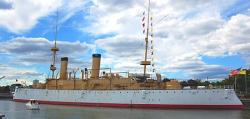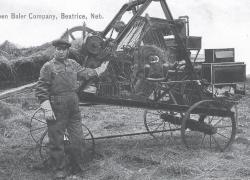The U.S.S. Olympia is one of the two surviving ships of the era of the vertical reciprocating steam engine. The Cruiser Olympia, launched in 1892, was one of the first naval ships to be built with these engines. As part of the new American steel Navy, the construction of the Olympia was authorized in 1888 as cruiser number 6. As part of a Congressionally-mandated program to establish complete domestic capability for warship construction, the ship's contract was awarded to the Union Iron Works of San Francisco.
1892


Luebben Hay Baler - Historic Landmark of Agricultural Engineering. In 1892, Hugh Luebben from Sutton, Nebraska, with sons Melchior and Ummo built a mobile machine to produce round hay bales between two sets of rotating flat belts. They began manufacturing the baler in 1909 in Beatrice and later moved to Omaha, Nebraska. Allis-Chalmers purchased the patent in 1939 and eventually sold 77,200 "Roto-Balers." The Luebben baler made handling easier, improved hay quality, and reduced costs. The same basic design is used on modern large round balers.

In 1892, John H. Froehlich, Froehlich, IA, Mounted A Gasoline Fueled Internal Combustion Engine On A Traction Geared Frame And Used It To Power A Threshing Machine. A Change In Power Source Had Begun On North American Farms. In 1892, The Case Co., Racine, Wi, Built An Experimental Gas Traction Engine. In 1898 A Patent Was Issued To The Van Duzen Co. Cincinnati, OH, For A Gasoline Traction Engine. Huber Mnfg., Marion, Oh, Bought This Patent In 1898 And Produced 30 Prototype Units. In 1902, Hart-Parr, Founded By Charles W. Hart And Charles H.

Charles C. Fenno Of Grinnell, Ia, Patented The First Field Corn Silage Harvester On April 19, 1892. His Ground-Powered Machine Cut The Corn Plant And Fed The Tassel End First To A Rotary Cutter. Joseph Weigel Of Flandreau, Sd, Improved Fenno's Harvester In 1912 By Adding An Engine To Power The Cutter And By Feeding The Stalks Butt End First. Andrean And Adolph Ronning, Farmers Of Boyd, Mn Patented Further Improvements In 1915. In 1918 The American Harvester Co. Of Minneapolis, Mn, Began Manufacturing The Horse-Drawn Ronning Harvester Using Weigel's Patent Too.

The Memphis Bridge (now called the Frisco Bridge) comprises three spans across the Mississippi River. With a main span measuring over 790 feet, it was one of the longest railroad bridges in the world upon completion. The renowned George Morison, after whom the bridge is unofficially named, served as Chief Engineer.

Innovations


The Memphis Bridge (now called the Frisco Bridge) comprises three spans across the Mississippi River. With a main span measuring over 790 feet, it was one of the longest railroad bridges in the world upon completion. The renowned George Morison, after whom the bridge is unofficially named,…
Read More
Charles C. Fenno Of Grinnell, Ia, Patented The First Field Corn Silage Harvester On April 19, 1892. His Ground-Powered Machine Cut The Corn Plant And Fed The Tassel End First To A Rotary Cutter. Joseph Weigel Of Flandreau, Sd, Improved Fenno's Harvester In 1912 By Adding An Engine To…
Read More
In 1892, John H. Froehlich, Froehlich, IA, Mounted A Gasoline Fueled Internal Combustion Engine On A Traction Geared Frame And Used It To Power A Threshing Machine. A Change In Power Source Had Begun On North American Farms. In 1892, The Case Co., Racine, Wi, Built An Experimental Gas…
Read More
Luebben Hay Baler - Historic Landmark of Agricultural Engineering. In 1892, Hugh Luebben from Sutton, Nebraska, with sons Melchior and Ummo built a mobile machine to produce round hay bales between two sets of rotating flat belts. They began manufacturing the baler in 1909 in Beatrice…
Read More
The U.S.S. Olympia is one of the two surviving ships of the era of the vertical reciprocating steam engine. The Cruiser Olympia, launched in 1892, was one of the first naval ships to be built with these engines. As part of the new American steel Navy, the construction of the Olympia was…
Read More

